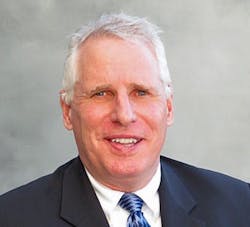Sponsored
As the electrical market prepares itself for the potential impact of President Trump’s 25% tariffs on imported steel and aluminum and potentially smaller copper tariffs, one thing is clear: any related price increases would rock the industry’s supply chain. Electrical manufacturers, distributors, independent manufacturers’ reps, electrical contractors and other end users would all be forced to charge more for their products and services if these tariffs on metals become a reality on March 4. Trump has given no date or exact percentage for copper tariffs, but metals experts believe they could be at least 10% and might align with the 25% tariffs on steel and aluminum.
While no one debates the importance of reshoring production steel-, aluminum- and copper-based products in the United States, it’s too early to tell if tariffs would be an effective tool to nudge more manufacturers of these products to build or expand state-side facilities. One also must consider the distinct possibility that companies could use tariffs to engineer price hikes that might go above and beyond the price increases costs for materials to pump up gross margins and cover other costs. That has happened in the past when tariffs hit the market, and it’s a reasonable expectation to think it could happen again.
Over the past two weeks, electrical trade association officials have spoken out on their willingness to work with the Trump Administration on its trade policies. NEMA President and CEO Debra Phillips issued a statement in response to the Administration’s announcement of 25% tariffs on U.S. imports from Canada and Mexico (currently paused until March 4), and an additional 10% tariff on U.S. imports from China now in effect.
"The U.S. electroindustry powers our economy with essential products that electrify and connect our nation’s grid, manufacturing facilities, homes, businesses and mobility systems,” she said. “It supports the goals of American energy independence, onshoring of critical manufacturing and energy supply chains, and a secure and resilient grid.
“Over the past seven years, the electroindustry has invested tens of billions of dollars in new and expanded U.S. manufacturing and created thousands of new jobs for American workers across the country. The U.S. electroindustry is the third largest U.S. exporter and second largest U.S. importer of manufactured goods and relies on one of the most complex global supply chains of any U.S. industry. The industry has taken major steps to reduce reliance on Chinese imports since 2018, decreasing China’s share of U.S. imports of electroindustry goods from 28.2% to 17.9%, while significantly growing electroindustry trade across North America by 36%, spurred by the United States-Mexico-Canada Agreement (USMCA).
“We look forward to working with the Trump Administration to further strengthen USMCA, including its enforcement and ensuring it incentivizes new investments and jobs in the United States. Introduction of tariffs should carefully consider their unique impact on critical manufacturing sectors that support our shared goals of increasing American energy production, growing domestic manufacturing and delivering a secure and reliable electric grid. NEMA looks forward to actively engaging with the Trump Administration and Congress on trade and tariff policies that support our shared objectives while promoting the electroindustry’s growth and competitiveness.”
The NEMA statement also said Trump’s decision to impose 25% tariffs on most goods imported from Canada and Mexico would assess annual duties of approximately $2.7 billion on U.S. imports of electroindustry goods from Canada and $14.7 billion on U.S. imports of electroindustry goods from Mexico, and that an additional 10% tariff on most goods imported from China would assess annual duties of approximately $4.4 billion on U.S. imports of electroindustry goods from China.
Wes Smith, president and CEO of the National Association of Electrical Distributors (NAED), issued the following statement on naed.org following President Trump’s initial announcement to levy 25% tariffs on imports to the United States from Canada and Mexico, which have been temporarily suspended:
“The electrical distribution industry is a vital conduit between electrical equipment manufacturers and electrical contractors. “Our network of more than 5,500 distributor locations and warehouses across every state and Congressional district employs more than 500,000 Americans with great careers that are essential to building and powering America’s homes, businesses, industrial facilities and data centers.
“We recognize that the President has used tariffs as a tool to rebalance trade practices, encourage domestic manufacturing, and achieve other policy objectives. Regardless of this, we stand ready to work with the Trump Administration and Congress to find the right balance on trade and tariff policies that expand domestic energy production, promotes a resilient supply chain, and helps ensure our grid is strong enough to reliably support our growing economy.”
Tariffs are not a done deal. In the past, President Trump has used a “Big Stick” negotiating policy to get the attention of other parties, and to then start negotiations on more favorable terms. We saw that recently with the recent negotiations with Mexico and Canada that extended the tariff deadline until next month. One major negative with the uncertainly over tariffs is that some manufacturers are hesitant to make capital investments until they know if tariffs are a go or not.
Make no mistake about it – the electrical industry could get hit harder by tariffs than many other industries because so many electrical products have high such high steel, aluminum and copper content. Wire and cable, conduit, enclosures, switchgear, panelboards, circuit protection devices, wiring devices, motors and fitting are just a few of the products that come to mind. To get a sense of the potential impact of tariffs on some of these product areas, take a look below at Electrical Marketing’s electrical product sales potential data for 2024 for some of these products:
Wire & cable: 13.3% of 2024 total distributor sales & $19.8 billion in estimated sales potentia
Switchgear: 8% of 2024 total distributor sales & $11.9 billion in estimated sales potential
Conduit & raceways: 3.4% of 2024 total distributors sales and $7.7 billion in estimated sales potential
Enclosures: 2.4% of 2024 total distributors’ sales and $3.5 billion in estimated sales potential
Tariffs were a key element of President’s Trump’s stump speeches and America First MAGA rhetoric at campaign rallies during his election campaign. Will they actually entice more manufacturers to reshore factories? That’s the multi-billion-dollar question.




